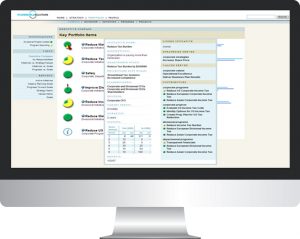To thrive in a data-centric world, it’s imperative that retail businesses retain control over their data — from how it’s created to who has access to it to where it’s stored.
The ubiquity of plastic charge cards and online payment accounts has, in that regard, proved to be both a blessing and a curse for retail companies. According to a report published by Javelin Strategy & Research, by 2017, only 23 percent of all point-of-sale purchases will be made with cash. The resulting wealth of transactional data can be a boon for those in the retail sector, but it also presents a source of risk in terms of data security and remaining compliant with PCI DSS standards.
Ubiquity has also led to fragmentation of data. Retailers commonly develop separate databases for retail point-of-sale, e-commerce and call centers, with information entered and stored differently in each case. Coordinating and streamlining marketing, sales and customer service Given this fragmentation, it is no surprise that it is challenging to coordinate marketing, sales and customer service across these endeavors — and that’s not even including the coming tsunami of data promised by the Internet of Things.
The importance of data governance, therefore, cannot be overstated. High-quality, well-managed data is crucial for decision-making, from the sales floor to the C-suite. Implementing a data governance framework, however, is a non-trivial endeavor. Questions of data ownership arise almost immediately, and the growing use of Big Data across departments — and even across enterprises — means that data inconsistencies (i.e. multiple versions of “the truth”) will also need to be addressed.
Just as a journalist is only as good as his or her sources, a retail company is only as good as the quality of its data. Retailers obtain data across myriad channels, from social media to mobile applications, and ideally use that data to provide predictive insights about consumer desire and demand. Because this data is gathered from disparate sources and is both structured and unstructured, making sense of it analytically requires that it be ‘cleansed’ and profiled to provide results most relevant for determining pricing, inventory management or marketing strategies.
Take marketing, for example. The most effective data governance strategies treat product and customer data as an asset, allowing marketers access to customer and household data to determine product and channel preferences. Establishing clear definitions of terms is crucial for these types of endeavors, from defining what is meant by “customer” as well as which customers are high-value, to determining which campaigns and budgets should be allocated to them. Such a strategy can save time and provide a competitive advantage by sparing the need for employees to manually search for data that pertains to customer buying habits and behavior. Furthermore, when customer service representatives are provided access to relevant customer data through proper governance, they’re better able to provide excellent service and thereby increase customer satisfaction and loyalty.
The risk involved in sharing such unstructured data across departments — say, from purchasing to marketing — is that it often requires the data be stored on a variety of internal and external sites to provide for adequate collaboration and accessibility. To mitigate the fear that employees might accidentally create sensitive content outside of the business systems, a robust governance strategy will ensure that there is a rationale for providing access to data, and the people with the access are the ones who are supposed to have access.
Merchandise pricing is another example of how data governance can improve the bottom line for those in the retail sector. The advent of online pricing transparency and price-comparison apps means a consumer can find the best deal on merchandise almost instantaneously. Retailers, therefore, must build precision into their pricing structures. Proper data governance and analytics will provide insight — on a continuous basis — into which discounts drive traffic, boost gift purchases or lead to impulse buys. By taking care to classify and provide structured access to data, a retailer might determine, for example, that the annual sale it holds during a holiday weekend is not actually driving sales the way it used to, or that a customer is willing to pay a premium for a product in exchange for a buying experience that places a high value on customer service, shipping speed or return policies.
This so-called “market-driven pricing” also provides a real-time forecast of supply, demand and the ever-changing proclivities among buyers in terms of what they are willing to spend. The resulting implications for supply-chain management are vast, According to a recent study from SCM World, 64 percent of supply chain executives consider big data analytics a disruptive and important technology that can provide fundamental insights for long-term change management going forward.
But getting to data analysis requires moving through data governance. Tools that facilitate master data management (MDM) — an important component of data governance — can help retail companies identify, access, integrate and synchronize data to optimize inventory management and distribute products based on real-time demand. Controlling and sharing data assets in such a way can also help companies better understand their relationships with suppliers and vendors by determining who is providing what to whom, which allows a more comprehensive assessment of supply chain efficiency and risks posed by traceability and product recalls.
The emerging Internet of Things (IoT) poses another huge challenge for data governance in the retail sector. Put it this way: Those who thought “big data” was big haven’t seen anything yet. During his keynote address at the Consumer Electronics Show earlier this year, Samsung CEO Jong-Kyun Shin said that by next year, nearly all of Samsung’s devices — which includes everything from air purifiers to smart TVs — will be connected to the Internet. The move toward IoT-enabled devices for other companies isn’t far behind. Tracking, controlling and providing access and quality control for the massive data expected to emerge from IoT will be important from the start in order to make sense of this deluge of data and determine the most lucrative — and least risky — strategies going forward.
 For a data governance program to remain adaptable and sustainable for the long-term, it’s essential to establish metrics and KPIs within the program itself to determine its effectiveness and provide “buy-in” from others in the organization. These KPIs can include product data quality, the number of changes to product data, invoicing discrepancies, pricing errors and inconsistent product hierarchies.
For a data governance program to remain adaptable and sustainable for the long-term, it’s essential to establish metrics and KPIs within the program itself to determine its effectiveness and provide “buy-in” from others in the organization. These KPIs can include product data quality, the number of changes to product data, invoicing discrepancies, pricing errors and inconsistent product hierarchies.
“To be effective, a data governance solution should classify data, evaluate risk, pinpoint any chinks in the security compliance armor and create processes for resolving data issues, while also setting parameters for usage in a systematic and proactive way,” says AJ Sarkar, CEO of Roundworld Solutions.
“Our 360-degree Big Data can help CXOs customize an end-to-end data integration and governance framework that allows all stakeholders to jointly design and optimize data. We’re here to help you extract the full value of the data, not just manage it.”
Learn More About Our 2 Week Assessment
or contact us directly today.
Tiffany Fox
Public Information Officer
RoundWorld Solutions

